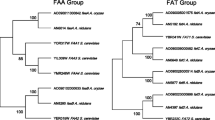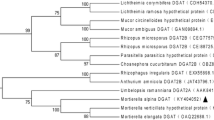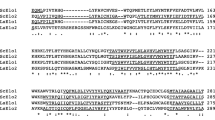Abstract
Aspergillus nidulans can use a variety of fatty acids as sole carbon and energy sources via its peroxisomal and mitochondrial β-oxidation pathways. Prior to channelling the fatty acids into β-oxidation, they need to be activated to their acyl-CoA derivates. Analysis of the genome sequence identified a number of possible fatty acyl-CoA synthetases (FatA, FatB, FatC, FatD, FaaA and FaaB). FaaB was found to be the major long-chain synthetase for fatty acid degradation. FaaB was shown to localise to the peroxisomes, and the corresponding gene was induced in the presence of short and long chain fatty acids. Deletion of the faaB gene leads to a reduced/abolished growth on a variety of fatty acids. However, at least one additional fatty acyl-CoA synthetase with a preference for short chain fatty acids and a potential mitochondrial candidate (AN4659.3) has been identified via genome analysis.




Similar content being viewed by others
References
Altschul SF, Madden TL, Schaffer AA, Zhang J, Zhang Z, Miller W, Lipman DJ (1997) Gapped BLAST and PSI-BLAST: a new generation of protein database search programs. Nucleic Acids Res 25:3389–3402
Andrianopoulos A, Hynes MJ (1988) Cloning and analysis of the positively acting regulatory gene amdR from Aspergillus nidulans. Mol Cell Biol 8:3532–3541
Armitt S, McCullough W, Roberts CF (1976) Analysis of acetate non-utilisating (acu) mutants in Aspergillus nidulans. J Gen Microbiol 92:263–282
Black PN, DiRusso CC (2003) Transmembrane movement of exogenous long chain fatty acids: proteins, enzymes, and vectorial esterification. Microbiol Mol Biol Rev 67:454–472
Black PN, DiRusso CC (2007) Vectorial acylation: linking fatty acid transport and activation to metabolic trafficking. Novartis Found Symp 286:127–38; discussion 138–141, 162–163, 196–203
Black PN, Zhang Q, Weimar JD, DiRusso CC (1997) Mutational analysis of a fatty acyl-coenzyme A synthetase signature motif identifies seven amino acid residues that modulate fatty acid substrate specificity. J Biol Chem 272:4896–4903
Boisnard S, Espagne E, Zickler D, Bourdais A, Riquet AL, Berteaux-Lecellier V (2009) Peroxisomal ABC transporters and β-oxidation during the life cycle of the filamentous fungus Podospora anserina. Fungal Genet Biol 46:55–66
Brocard C, Hartig A (2006) Peroxisome targeting signal 1: is it really a simple tripeptide? Biochim Biophys Acta 1763:1565–1573
Connerton IF, Fincham JRS, Sanddeman RA, Hynes MJ (1990) Comparison and cross-species expression of the acetyl CoA synthetase genes of the ascomycete fungi Aspergillus nidulans and Neurospora crassa. Mol Microbiol 4:451–460
Cove DJ (1966) The induction and repression of nitrate reductase in the fungus Aspergillus nidulans. Biochim Biophys Acta 113:51–56
Davis MA, Cobbett CS, Hynes MJ (1988) An amdS-lacZ fusion for studying gene regulation in Aspergillus. Gene 63:199–212
DiRusso CC, Black PN (2004) Bacterial long chain fatty acid transport: gateway to a fatty acid-responsive signaling system. J Biol Chem 279:49563–49566
Hiltunen JK, Mursula AM, Rottensteiner H, Wierenga RK, Kastaniotis AJ, Gurvitz A (2003) The biochemistry of peroxisomal beta-oxidation in the yeast Saccharomyces cerevisiae. FEMS Microbiol Rev 27:35–64
Hynes MJ, Murray SL, Duncan A, Khew GS, Davis MA (2006) Regulatory genes controlling fatty acid catabolism and peroxisomal functions in the filamentous fungus Aspergillus nidulans. Eukaryot Cell 5:794–805
Hynes MJ, Murray SL, Khew GS, Davis MA (2008) Genetic analysis of the role of peroxisomes in the utilization of acetate and fatty acids in Aspergillus nidulans. Genetics 178:1355–1369
Janssen PH, Schink B (1995) Catabolic and anabolic enzyme activities and energetics of acetone metabolism of the sulfate-reducing bacterium Desulfococcus biacutus. J Bacteriol 177:277–282
Knoll LJ, Johnson DR, Gordon JI (1994) Biochemical studies of three Saccharomyces cerevisiae acyl-CoA synthetases, Faa1p, Faa2p, and Faa3p. J Biol Chem 269:16348–16356
Lee SB, Taylor JW (1990) Isolation of DNA from fungal mycelia and single spores. In: Innis MA, Gelfand DH, Sninsky JS, White TJ (eds) PCR protocols: a guide to methods and applications. Academic Press, San Diego, pp 282–287
Lee D, Ellard M, Wanner LA, Davis KR, Douglas CJ (1995) The Arabidopsis thaliana 4-coumarate:CoA ligase (4CL) gene: stress and developmentally regulated expression and nucleotide sequence of its cDNA. Plant Mol Biol 28:871–884
Maggio-Hall LA, Keller NP (2004) Mitochondrial beta-oxidation in Aspergillus nidulans. Mol Microbiol 54:1173–1185
Maggio-Hall LA, Lyne P, Wolff JA, Keller NP (2008) A single acyl-CoA dehydrogenase is required for catabolism of isoleucine, valine and short-chain fatty acids in Aspergillus nidulans. Fungal Genet Biol 45:180–189
Morgan-Kiss RM, Cronan JE (2004) The Escherichia coli fadK (ydiD) gene encodes an anerobically regulated short chain acyl-CoA synthetase. J Biol Chem 279:37324–37333
Morsczeck C, Berger S, Plum G (2001) The macrophage-induced gene (mig) of Mycobacterium avium encodes a medium-chain acyl-coenzyme A synthetase. Biochim Biophys Acta 1521:59–65
Nayak T, Szewczyk E, Oakley CE, Osmani A, Ukil L, Murray SL, Hynes MJ, Osmani SA, Oakley BR (2006) A versatile and efficient gene-targeting system for Aspergillus nidulans. Genetics 172:1557–1566
Reiser K, Davis MA, Hynes MJ (2009) AoxA is a major peroxisomal long chain fatty acyl-CoA oxidase required for beta-oxidation in A. nidulans. Curr Genet doi:10.1007/s00294-009-0286-2
Sambrook J, Fritsch EF, Maniatis F (1989) Molecular cloning: a laboratory manual. Cold Spring Harbor Laboratory Press, Cold Spring Harbor
Scharnewski M, Pongdontri P, Mora G, Hoppert M, Fulda M (2008) Mutants of Saccharomyces cerevisiae deficient in acyl-CoA synthetases secrete fatty acids due to interrupted fatty acid recycling. FEBS J 275:2765–2778
Spröte P, Brakhage AA, Hynes MJ (2009) Contribution of peroxisomes to penicillin biosynthesis in Aspergillus nidulans. Eukaryot Cell 8:421–423
Steinberg SJ, Morgenthaler J, Heinzer AK, Smith KD, Watkins PA (2000) Very long-chain acyl-CoA synthetases. J Biol Chem 275:35162–35169
Szewczyk E, Andrianopoulos A, Davis MA, Hynes MJ (2001) A single gene produces mitochondrial, cyoplasmic, and peroxisomal NADP-dependant isocitrate dehydrogenase in Aspergillus nidulans. J Biol Chem 276:37722–37729
Thompson JD, Higgins DG, Gibson TJ (1994) CLUSTAL W: improving the sensitivity of progressive multiple sequence alignment through sequence weighting, position-specific gap penalties and weight matrix choice. Nucleic Acids Res 22:4673–4680
Todd RB, Davis MA, Hynes MJ (2007) Genetic manipulation of Aspergillus nidulans: meiotic progeny for genetic analysis and strain construction. Nat Protoc 2:811–821
Weidner G, d’Enfert C, Koch A, Mol PC, Brakhage AA (1998) Development of a homologous transformation system for the human pathogenic fungus Aspergillus fumigatus based on the pyrG gene encoding orotidine 59-monophosphate decarboxylase. Curr Genet 33:378–385
Zhang YQ, Brock M, Keller NP (2004) Connection of propionyl-CoA metabolism to polyketide biosynthesis in Aspergillus nidulans. Genetics 168:785–794
Zou Z, DiRusso CC, Ctrnacta V, Black PN (2002) Fatty acid transport in Saccharomyces cerevisiae. Directed mutagenesis of FAT1 distinguishes the biochemical activities associated with Fat1p. J Biol Chem 277:31062–31071
Zou Z, Tong F, Færgeman NJ, Borsting C, Black PN, DiRusso CC (2003) Vectorial acylation in Saccharomyces cerevisiae. Fat1p and fatty acyl-CoA synthetase are interacting components of a fatty acid import complex. J Biol Chem 278:16414–16422
Acknowledgments
This work was supported by the Australian Research Council.
Author information
Authors and Affiliations
Corresponding author
Additional information
Communicated by Erko Stackebrandt.
Electronic supplementary material
Below is the link to the electronic supplementary material.
Rights and permissions
About this article
Cite this article
Reiser, K., Davis, M.A. & Hynes, M.J. Aspergillus nidulans contains six possible fatty acyl-CoA synthetases with FaaB being the major synthetase for fatty acid degradation. Arch Microbiol 192, 373–382 (2010). https://doi.org/10.1007/s00203-010-0565-9
Received:
Revised:
Accepted:
Published:
Issue Date:
DOI: https://doi.org/10.1007/s00203-010-0565-9




